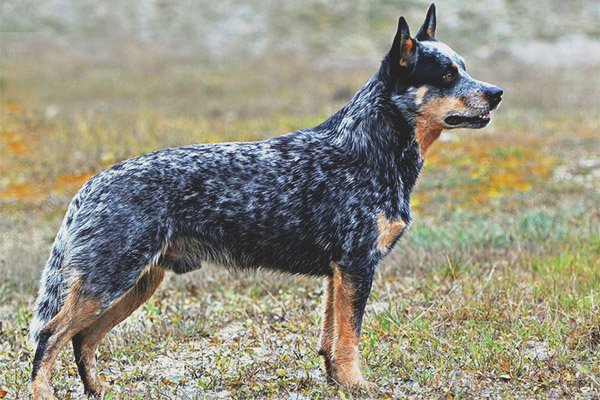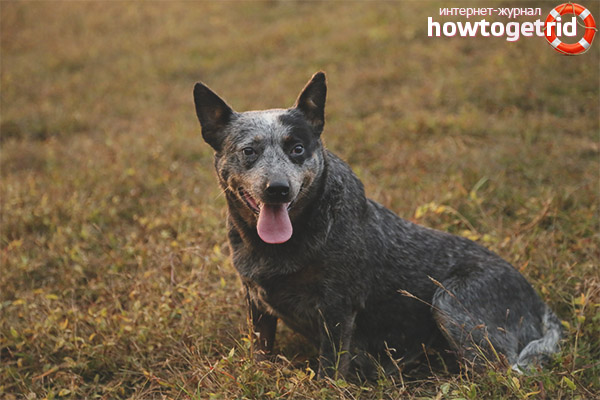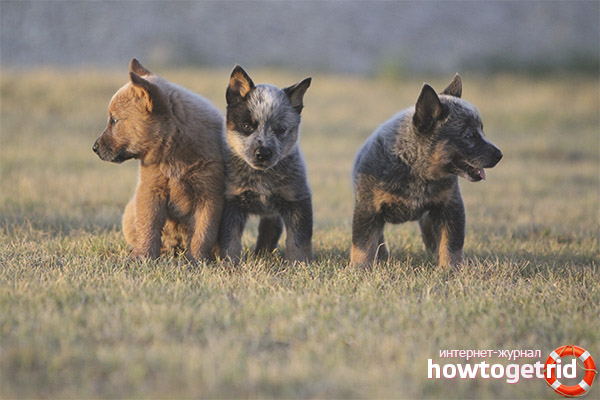The content of the article
These clever and quick-witted animals are considered a landmark of the Australian contingent. Healer is a devoted friend of a person who has a unique shepherd talent. By the way, his skills in dealing with cattle are the main distinguishing feature of this dog.
From the history of the breed
The ancestors of the Australian healers are the wild dingo dogs. The name of the breed is translated from English as "heel". The reason for this was their peculiarity to bite cattle in the back of the leg, thus driving them into a stall.
The breed was bred by the English colonizers in order to get the perfect shepherd dog for driving cattle over long distances. Australian farmer T. Hall crossed short-haired collie with wild Australian dingoes.For a long time, the healers were available only at Hall himself on the premises, and after he had retired to another world, the breed spread to the Australian continent.
To improve the breed, the collectors continued to cross the healers with the Dalmatians, collie and bull terriers. This led to the emergence of 2 new breeds: the Australian short-tailed herding dog and the Australian herding dog.
Breed description
The official name of the Australian healers - Cattle Dog. The external data of this breed are similar to some extent with the collie.
- Torso These animals are medium sized dogs. Males have 45-52 cm at the withers and weight is about 21 kg, and bitches are slightly less - up to 50 cm and weight about 20 kg. Visually, the dog seems tall and small in length. Powerful body, muscular body.
- Head. Proportional to the body. Large size, wide.
- Limbs. Round shape. Paw pads are oval. The hind limbs are strong and wide.
- Tail. Low set. Do not stop. With a small tassel on the end.
- Ears. With a wide base and pointed at the end. Small in size.
- Eyes. Oval shape. The iris is brown. Their view is meaningful.
- Nose. Proportional, with a black tip.
- Wool. Thick, with a dense short undercoat. It has good thermoprotective properties.
Colors
There are several types:
- Red. Uniform red specks all over the body and undercoat (not cream and not white). On the head may be red spots of a darker color. The presence of uniform markings on the head is desirable. Red markings on the body are acceptable, but are considered a fault.
- Blue. Maybe with specks or without. Spots in the head of black, blue, pale yellow colors are allowed. The presence of a pale yellow undercoat is permissible if it does not look out of the guard coat. The disadvantage is the presence of black markings on the body.
Character traits
Kettle dog was originally bred as a shepherd's breed, and today he is still a great watchman and companion. In addition, they have excellent intelligence, loyalty and loyalty to their owners. Extraordinarily tied to their owners. Dogs of this breed are affectionate and gentle, but unobtrusive.
Healers infinitely love their owners, and with other members of the family they are simply friendly and livable. Nevertheless, intelligent and courageous, they are ready for anything, protecting their territory.By the type of temperament, they are extroverts: active and inquisitive, very sociable.
With young children, they are usually great friends. Healers condescendingly treat childish pranks and are ready to forgive them for almost everything. They perceive children as puppies from the pack, therefore they seek to coordinate their behavior.
Completely different relationships, less tethered, add up with other pets. Dogs of this breed consider themselves owners in their own territory, they try to dominate over all pets with which they live, and sometimes over the owner itself.
Training
These intelligent animals are perfectly trained from a young age. For this purpose, a puppy should be provided to a professional trainer. Education is possible only by humane methods, the healer will not tolerate any physical punishment. But traditional training brings them a lot of joy and pleasure, they are quite clever and trainable. During the training of dogs of this breed, the use of physical force and shouts are simply unacceptable.
The joy of life is reflected in the dog's face smile. By the way, she appears at them often enough.However, when she is absent, her eyes are wary - the dog should beware.
Features of maintenance and care
Kettle dogs are not suitable for maintenance in the apartment. They can simply escape from it for the next portion of adventure. Most of all for this breed of dogs are suitable private houses with a large territory and free range. These animals are very active, they can not live without physical activity and long walks.
They can accompany the owners during nature walks or sports. If healers are bored, they can just run off. The dog independently is able to open doors and it happens that it digs a trench under the fence in an attempt to gain will. Therefore, to keep the animal better in the aviary.
Grooming
With the exception of the molts, grooming does not give the owners special trouble. It needs only to be brushed occasionally with a special brush, removing the loose wool with a wet hand or a special glove. This procedure is done on average once a week and every other day during periods of molting.
It is not necessary to bathe a pet often. And it is better to do it only in case of extreme necessity with the help of a special or odorless baby shampoo.
Claws and paws
The animal is quite active and during physical activity the claws grind off independently. Once a month it is necessary to trim a rudimentary claw.
Because of the strong love of walking, the pillows on the legs may crack. They must be periodically processed by washing with water and lubricated with oil or moisturizing cream with healing properties.
Eyes
They are an identifier of the animal's health status. If they are inflamed or sour, it is advisable to show the dog to the vet. Eyes should be inspected once a week and, if necessary, washed with a decoction of chamomile or calendula with a cotton pad.
Teeth cleaning
For healers, like all dogs, dental health is very important. For this reason, it is so important to keep them healthy. To preserve the health of teeth, the diet of the animal should be as diverse as possible with the inclusion of solid food.
Brushing your teeth should be done at least once a week. This should be done with the help of special dog paste and soft brush.
Teaching your pet to brush your teeth is necessary from an early age, otherwise an adult dog may have difficulty with this.When a dog is accustomed to this procedure, then in an adult animal, as a rule, this does not cause problems.
Nutrition
For an animal to be healthy and active, its diet should be as diverse as possible. As a rule, healers have a good appetite, but rarely tend to suffer from excess weight. Dogs of this breed are very active and therefore consume a lot of calories. Since they are by nature animals that prefer the will, it is better to choose natural food, using special dry food only in the most extreme cases.
The basis of the diet should be meat, fish and offal. It is desirable to give them in a raw state, the meat is pre-scalded with boiling water. In no case should not be given a raw liver, it can lead to infection of the animal with worms.
Additionally, their diet must contain:
- eggs;
- cereals: oatmeal, rice, buckwheat;
- fish;
- vegetables: beets, carrots, cabbage, zucchini;
- vegetable oil;
- milk products.
Trying to diversify the pet's food as much as possible, it is necessary to take into account the products that should not be given to the dog for food.
List of banned products:
- pastry;
- citrus fruit;
- fatty meat (pork);
- condiments, including garlic;
- smoked meat;
- corned beef;
- sweets;
- mushrooms;
- cereals: wheat and barley.
Mating
The adult female healer is ready to mate approximately 2 times a year. Without waiting for heat, the lady must first pick up the groom. Before viscous, you should show the animal to the veterinarian and preliminarily deworming. This applies to owners of animals of both sexes.
The owners stipulate in advance all the conditions of mating pets and the price. All necessary documents and a veterinary passport must be provided to each other. Contractual terms may be in written or oral form at the request of the owners.
De-worming
Regardless of the conditions in which the animal is kept. The risk of infection by parasites is always large enough. Therefore, once a quarter, dogs and puppies need to be de-wormed for preventive purposes. In this way, you can protect yourself and other pets from possible infection. This is of particular importance in front of matings, since infection with parasites can occur in puppies in utero through the bloodstream and when fed with mother's milk.
Puppies can be anthelmintic starting at 3 weeks of age. For them, parasitic infections are very dangerous, they can lead to developmental delays and even death. Strangely enough, most often pets become infected from their owners.
Health and life expectancy
Usually, Australian shepherd dogs have an enviable health. They perfectly adapt to any conditions of detention and residence thanks to the genes obtained from their wild ancestors.
Healers are long-lived dogs. On average, their life expectancy is about 15 years, but there are cases when animals of this breed lived to a much more respectable age. However, some individuals may suffer from characteristic genetic diseases:
- Congenital deafness.
- Hip dysplasia.
- Predisposition to congenital, gradually developing blindness.
- Lack of teeth.
These diseases can be identified by special genetic analysis. Such animals are excluded from breeding and must be sterilized.
Of all puppies, about 2% are born deaf. 14% have unilateral deafness.Most often it affects individuals with white markings. At birth, they have a white solid color, like the Dalmatians. The latter transmitted to the healers their genetic susceptibility to hearing loss.
Studies of this breed have shown that individuals with speckled color do not have a predisposition to congenital deafness. On the territory of Russia, it is believed that the most healthy litter is obtained by mating individuals of the blue and red color. But these data do not have scientific evidence.
Animals with hip dysplasia in their homeland are excluded from breeding. In Europe, this rule has also begun to be followed recently. Therefore, their genes were animals that have moved to America, England, France. 50% of healers in Finland suffer from this disease. Most often it occurs in large representatives of this breed.
Healers often have an inborn lack of teeth. Given the characteristics of the breed, the standards allowed to have such a disadvantage - the maximum number of missing teeth - 3 pcs. The remaining animals are rejected.
How much and where to buy?
The price of the healer depends on many factors. Naturally, it affects her - pedigree data and pedigree. The demand for puppies in winter is more than in summer, and this also affects the cost. It is better to buy a quadruped friend in a specialized nursery than from an unknown seller. Because instead of a purebred dog, there is a risk to buy an ordinary homebred mongrel "Ball".
On average, a puppy of this breed costs 400-1000 US dollars.
Video: Australian Cattle Dog














To send